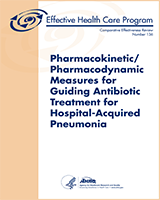NCBI Bookshelf. A service of the National Library of Medicine, National Institutes of Health.
Structured Abstract
Objective:
To conduct a systematic review of the use of pharmacokinetic/pharmacodynamic (PK/PD) measures or strategies to dose and monitor intravenous (IV) antibiotics in the treatment of adults with hospital-acquired pneumonia (HAP).
Data sources:
MEDLINE® (via PubMed), Cochrane Library, International Pharmaceutical Abstracts, and ClinicalTrials.gov from January 1, 2004, to June 7, 2014.
Review method:
Two investigators independently selected, extracted data from, and rated risk of bias of studies. We graded strength of evidence based on established guidance.
Results:
Ten studies (seven trials, three cohort studies) met inclusion criteria. Evidence is insufficient to conclude whether using PK/PD measures to inform decisions about dosing or monitoring IV antibiotic treatment improves either intermediate or health outcomes. One trial (rated high risk of bias) used PK/PD measures to study the impact of different antibiotic dosing levels on clinical responses, such as time on mechanical ventilation, treatment failure, and mortality.
Evidence is also insufficient to draw conclusions about the effect of continuous infusions of beta-lactam antibiotics compared with the effect of intermittent infusions on outcomes related to clinical response, mechanical ventilation, morbidity, mortality, or rates of antibiotic-related adverse events. Clinical response, duration of mechanical ventilation, superinfection, rates of antibiotic-related adverse events, and infusion-related adverse effects did not differ significantly in any study.
Conclusions:
Despite the theoretical advantages of optimizing IV antibiotic dosing using PK/PD principles in patients with HAP, major gaps in the available evidence preclude our drawing conclusions or explaining clinical or policy implications. The near absence of strong evidence, particularly related to clinical applications, limits our ability to either support or oppose the adoption of various PK/PD strategies for this specific clinical purpose.
Contents
Prepared for: Agency for Healthcare Research and Quality, U.S. Department of Health and Human Services1, Contract No. 290-2012-00008-I. Prepared by: RTI International–University of North Carolina at Chapel Hill Evidence-based Practice Center, Research Triangle Park, NC
Suggested citation:
Lux LJ, Posey RE, Daniels LS, Henke DC, Durham C, Jonas DE, Lohr KN. Pharmacokinetic/Pharmacodynamic Measures for Guiding Antibiotic Treatment for Hospital-Acquired Pneumonia. Comparative Effectiveness Review No. 136. (Prepared by the RTI–University of North Carolina at Chapel Hill Evidence-based Practice Center under Contract No. 290-2012-00008-I.) AHRQ Publication No. 14(15)-EHC032-EF. Rockville, MD: Agency for Healthcare Research and Quality; November 2014. www.effectivehealthcare.ahrq.gov/reports/final.cfm.
This report is based on research conducted by the RTI International–University of North Carolina at Chapel Hill Evidence-based Practice Center (EPC) under contract to the Agency for Healthcare Research and Quality (AHRQ), Rockville, MD (Contract No. 290-2012-00008-I). The findings and conclusions in this document are those of the authors, who are responsible for its contents; the findings and conclusions do not necessarily represent the views of AHRQ. Therefore, no statement in this report should be construed as an official position of AHRQ or of the U.S. Department of Health and Human Services.
The information in this report is intended to help health care decisionmakers—patients and clinicians, health system leaders, and policymakers, among others—make well informed decisions and thereby improve the quality of health care services. This report is not intended to be a substitute for the application of clinical judgment. Anyone who makes decisions concerning the provision of clinical care should consider this report in the same way as any medical reference and in conjunction with all other pertinent information, i.e., in the context of available resources and circumstances presented by individual patients.
AHRQ or U.S. Department of Health and Human Services endorsement of any derivative products that may be developed from this report, such as clinical practice guidelines, other quality enhancement tools, or reimbursement or coverage policies, may not be stated or implied.
This report may periodically be assessed for currency. If an assessment is done, the resulting surveillance report describing the methodology and findings will be found on the Effective Health Care Program Web site at: www.effectivehealthcare.ahrq.gov. Search on the title of the report.
None of the investigators have any affiliations or financial involvement that conflicts with the material presented in this report.
- 1
540 Gaither Road, Rockville, MD 20850; www
.ahrq.gov
- NLM CatalogRelated NLM Catalog Entries
- Review Aspirin Use in Adults: Cancer, All-Cause Mortality, and Harms: A Systematic Evidence Review for the U.S. Preventive Services Task Force[ 2015]Review Aspirin Use in Adults: Cancer, All-Cause Mortality, and Harms: A Systematic Evidence Review for the U.S. Preventive Services Task ForceWhitlock EP, Williams SB, Burda BU, Feightner A, Beil T. 2015 Sep
- Review Low-Dose Aspirin for the Prevention of Morbidity and Mortality From Preeclampsia: A Systematic Evidence Review for the U.S. Preventive Services Task Force[ 2014]Review Low-Dose Aspirin for the Prevention of Morbidity and Mortality From Preeclampsia: A Systematic Evidence Review for the U.S. Preventive Services Task ForceHenderson JT, Whitlock EP, O'Conner E, Senger CA, Thompson JH, Rowland MG. 2014 Apr
- Review Lipid Screening in Childhood for Detection of Multifactorial Dyslipidemia: A Systematic Evidence Review for the U.S. Preventive Services Task Force[ 2016]Review Lipid Screening in Childhood for Detection of Multifactorial Dyslipidemia: A Systematic Evidence Review for the U.S. Preventive Services Task ForceLozano P, Henrikson NB, Morrison CC, Dunn J, Nguyen M, Blasi P, Whitlock EP. 2016 Aug
- Review Continuous infusion vs. bolus dosing: implications for beta-lactam antibiotics.[Minerva Anestesiol. 2012]Review Continuous infusion vs. bolus dosing: implications for beta-lactam antibiotics.Mohd Hafiz AA, Staatz CE, Kirkpatrick CM, Lipman J, Roberts JA. Minerva Anestesiol. 2012 Jan; 78(1):94-104. Epub 2011 Jul 6.
- Review Biomarkers for Assessing and Managing Iron Deficiency Anemia in Late-Stage Chronic Kidney Disease[ 2012]Review Biomarkers for Assessing and Managing Iron Deficiency Anemia in Late-Stage Chronic Kidney DiseaseChung M, Moorthy D, Hadar N, Salvi P, Iovin RC, Lau J. 2012 Oct
- Pharmacokinetic/Pharmacodynamic Measures for Guiding Antibiotic Treatment for Ho...Pharmacokinetic/Pharmacodynamic Measures for Guiding Antibiotic Treatment for Hospital-Acquired Pneumonia
Your browsing activity is empty.
Activity recording is turned off.
See more...
